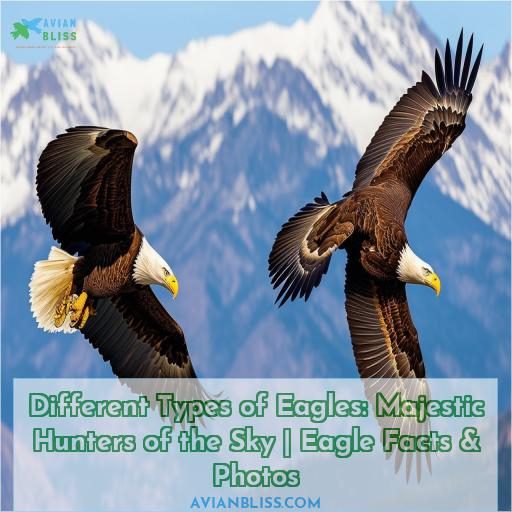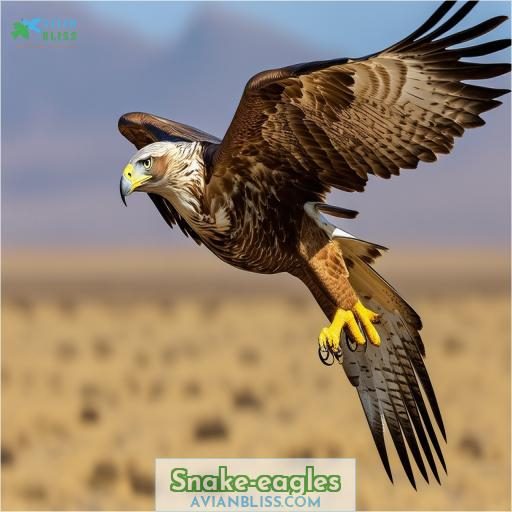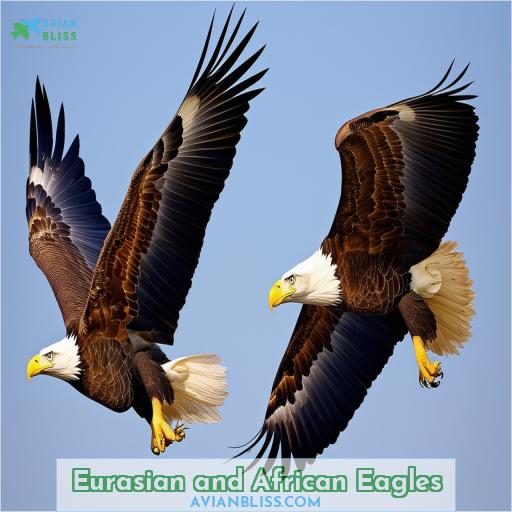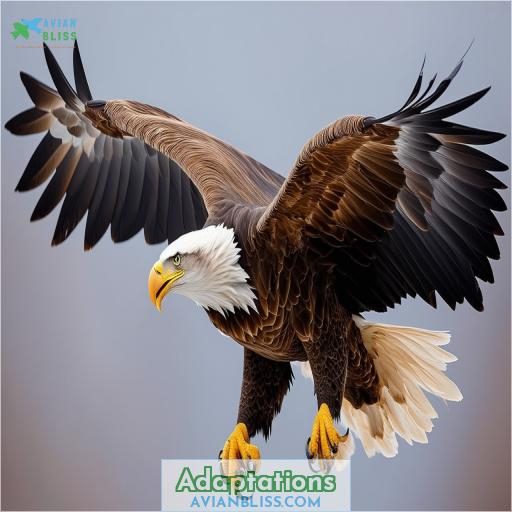This site is supported by our readers. We may earn a commission, at no cost to you, if you purchase through links.
 Explore the incredible world of different types of eagles, from the massive sea eagles, with their colossal wings and powerful talons, to the specialized snake-eagles that boldly hunt reptiles with precision.
Explore the incredible world of different types of eagles, from the massive sea eagles, with their colossal wings and powerful talons, to the specialized snake-eagles that boldly hunt reptiles with precision.
You’ll find species like Steller’s Sea Eagle dominating arctic waters and the agile Philippine Serpent Eagle soaring through tropical forests.
Other notable eagles include the formidable Golden Eagle and the majestic Martial Eagle, both known for their impressive strength and hunting skills. These raptors span diverse habitats worldwide, showcasing an array of fascinating adaptations.
Intrigued by their unique traits and behaviors? There’s much more to uncover about these majestic hunters.
Table Of Contents
Key Takeaways
- Eagles come in all shapes and sizes, from tiny serpent eagles to massive harpy eagles.
- These birds of prey have incredible hunting skills, using their sharp talons and powerful eyesight to capture everything from fish to monkeys.
- Eagles are found all over the world, from the Arctic to the tropics.
- These majestic birds are threatened by habitat loss and other human activities, so it’s important to do our part to protect them.
Sea Eagles
You’re about to learn about a remarkable group of eagles known as sea eagles. These raptors, including the Steller’s Sea Eagle, White-tailed Eagle, Bald Eagle, African Fish Eagle, and Pallas’s Fish Eagle, are superbly adapted to coastal environments, possessing remarkable fishing abilities and distinctive physical characteristics.
Steller’s Sea Eagle
You’ll marvel at Steller’s Sea Eagle – colossal wings, fearsome talons, unrivaled fishing prowess amidst arctic waters.
White-tailed Eagle
Looking majestic, the white-tailed eagle soars:
- Broad wings glide effortlessly
- Piercing eyes scan for prey
- Powerful talons poised to strike
- Dominant force in the skies
The white-tailed eagle reigns supreme over its domain with a regal presence. Its massive wingspan casts an imposing shadow as it soars gracefully on thermal updrafts. This apex predator scans the terrain below with unrivaled eyesight, its razor-sharp talons at the ready to snatch unsuspecting prey.
While related to the iconic bald eagle, the white-tailed eagle cuts a distinct figure. Slightly larger and more robust, this raptor sports a unique plumage that sets it apart. The body feathers boast a rich, dark brown hue contrasted by a pale head and broad white tail – giving it an almost two-toned appearance from afar.
Adapting to diverse environments across Eurasia, the white-tailed eagle displays remarkable versatility. These birds thrive near coasts, lakes, and rivers where fish provide a dietary staple. But their hunting prowess extends to smaller mammals and birds as well. With power, precision and an instinctive mastery of the air, few prey are off-limits to these formidable aerial hunters.
Bald Eagle
You’re fascinated by the bald eagle, aren’t you? Our national bird holds symbolic power—a majestic avian predator.
African Fish Eagle
If you’re intrigued by sea eagles, meet the African Fish Eagle. It:
- Boasts a striking black-and-white plumage
- Emits a unique, haunting call
- Plays an iconic role in African cultures
Pallas’s Fish Eagle
You’ll find Pallas’s fish eagles soaring over central Asia’s open water and coastal areas, hunting fish.
Snake-eagles
You’re about to explore a fascinating group of eagles known as snake-eagles. These raptors, including the Crested Serpent Eagle, Short-toed Snake Eagle, Brown Snake Eagle, Philippine Serpent Eagle, and Madagascar Serpent Eagle, are specialized hunters that primarily prey on snakes, employing their sharp talons and hooked beaks to capture and subdue their slithering targets.
Crested Serpent Eagle
The crested serpent eagle, a formidable predator with bold crests and piercing eyes, soars majestically, hunting serpents in forests across Asia.
Short-toed Snake Eagle
The short-toed snake eagle is a skilled hunter with sharp eyes and talons for catching snakes, lizards, and other reptilian prey.
Brown Snake Eagle
Brown snake eagles adeptly camouflage, exhibiting formidable snake-eating prowess in African forests near wetlands.
Philippine Serpent Eagle
You’ll see the stunning Philippine serpent eagle soaring effortlessly over tropical Philippines forests, hunting small mammals and reptiles.
Madagascar Serpent Eagle
And found in Madagascar, the ‘Madagascar Serpent Eagle’ nests in tall trees, hunting small mammals from high altitudes.
- Distinctive dark-brown plumage
- Reddish-brown barring on underwing
- Long, curved yellow beak
This eagle is a graceful hunter, gliding effortlessly on thermal winds while scanning the forest below for prey. Once it locks onto a target, it’ll swoop down with remarkable speed and agility to seize the unsuspecting mammal with its powerful talons. You can’t help but admire the raw power and precision of this skilled predator. Witnessing one of these majestic raptors in action is an unforgettable sight that’ll leave you in awe of nature’s majesty.
Other Eagle Species
You’re now venturing into the domain of some of the most formidable eagle species known to humans. Fearsome hunters like the Golden Eagle, Martial Eagle, Harpy Eagle, Crowned Eagle, and Black Eagle possess incredible strength, sharp talons, and hunting prowess that make them apex predators in their respective habitats.
Golden Eagle
The golden eagle soars worldwide, its chocolate-brown feathers and golden nape recognizable. In North America, watch for eagles passing through multiple age-related plumages, from white-tailed immatures to uniformly dark adults with broad wings.
Martial Eagle
Continuing our majestic journey, the martial eagle, Africa’s largest, hunts impressively huge prey thanks to fierce talons and agility.
Harpy Eagle
The harpy eagle’s immense power lets it dominate rainforest canopies.
- Massive talons crush prey
- Distinctive crested head
- Endangered by deforestation
Crowned Eagle
You marvel at the crowned eagle, a powerful apex predator dominating African forests with its massive size and impressive hunting skills.
| Crowned Eagle Might | Regal Splendor | Forest Dominion |
|---|---|---|
| Powerful talons crush prey | Striking crown of feathers | Controls territory from canopy |
| Immense wingspan commands airspace | Piercing eyes survey kingdom | Apex predator of woodlands |
| Relentless hunter of monkeys, antelopes | Majestic frame exudes authority | Fierce guardian of ancient trees |
Black Eagle
You’ll encounter the mighty Black Eagle, a dominant raptor facing habitat loss despite conservation efforts.
Eurasian and African Eagles
You’ll find impressive eagles like the Bonelli’s Eagle, Booted Eagle, Greater Spotted Eagle, Lesser Spotted Eagle, and Spanish Imperial Eagle across Eurasia and Africa. These majestic raptors possess remarkable hunting abilities and distinct physical characteristics that set each species apart.
Bonelli’s Eagle
Bonelli’s eagle: fascinating hunter thriving across Europe, Asia, and Africa. 1) Compact build 2) Rufous plumage 3) Nimble flyer. Cultural icon, conservation matters.
Booted Eagle
You’ll find the booted eagle across Eurasia and Africa. Its taxonomy recently changed, reflecting conservation concerns from habitat loss.
Greater Spotted Eagle
You’ll next discover the greater spotted eagle, a powerful raptor with striking plumage migrating across vast Eurasian landscapes.
Lesser Spotted Eagle
You won’t miss the lesser spotted eagle’s striking markings:
- Pale blue-grey head and wings
- Dark brown streaking
- White underparts
- Pale yellow eyes
- Soars on thermals
Spanish Imperial Eagle
You witness the Spanish Imperial Eagle, a majestic raptor facing habitat loss. Conservation measures like protecting nesting sites aim to secure its future.
| Species | Key Facts |
|---|---|
| Spanish Imperial Eagle | Endangered, breeds in Spain and Morocco. |
| Philippine Hawk-Eagle | Critically endangered, found only in Philippines. |
| Wallace’s Hawk-Eagle | Vulnerable, lives in Indonesia and Malaysia. |
| Long-Crested Eagle | Near threatened, Sub-Saharan Africa resident. |
American Eagles
Let’s take a look at two unique eagle species found in the Americas – the Black Hawk-Eagle and the Solitary Eagle. These powerful raptors possess distinct physical and behavioral traits that set them apart from other eagle species on the continent.
Black Hawk-Eagle
So let’s discuss the Black Hawk-Eagle now. This raptor, found in Southeast Asia, showcases:
- Striking black plumage with white markings
- Powerful talons perfect for capturing monkeys and birds
- Impressive wingspan up to 5 feet
- Sadly, deforestation threatens its tropical forest habitat
Despite its "hawk" name, the Black Hawk-Eagle is a true eagle species – an expert aerial predator deserving our awe and conservation efforts.
Solitary Eagle
You’re fascinated by the Solitary Eagle, a powerful predator that embodies freedom. Found in the Americas, it’s an apex hunter that prefers undisturbed forests and dense woodlands. Witness its solitary hunting prowess:
| Behavior | Description |
|---|---|
| Aerial Attacks | Stoops at high speeds onto prey |
| Perch Hunting | Patiently waits on tree branches |
| Cooperative Pairs | Mates coordinate complex hunts |
Conserving this majestic eagle preserves nature’s wild spirit.
Physical Description
Eagles, magnificent raptors that soar through the skies, exhibit a remarkable range in their physical dimensions. From the diminutive 16-inch serpent eagles to towering 3-foot harpy eagles, their sizes vary considerably; their weight spans nearly 15 pounds, with wingspans extending an impressive 7 feet across.
Size
Eagles vary greatly in size. Here are some key points:
- From 16 inches to over 3 feet tall
- Wingspan up to 7 feet 2 inches
- The largest eagles have powerful eyesight and build massive nests
Weight
Eagles’ weights range from mere pounds to over 15 lbs, perfectly balanced with their impressive wingspans for effortless soaring and aerial hunting prowess.
Wingspan
Eagles’ wingspans range from 3.5 to over 7 feet across, reflecting adaptations for flight and hunting strategies.
Color
You’ll find eagles cloaked in dark-colored, brown, or blackish feathers. Their plumage evolves through molts revealing unique age-related variations.
Eyes
Their eyes are 4-8 times stronger than ours, helping them spot prey from miles away. Their eyes have:
- Large size for increased visual acuity
- Specialized muscles for precise eye movements
- Color variations adapted for different environments
- Protective features against infections and damage
Habitat and Distribution
Eagles are found across Europe, Africa, Asia, Australia, South and Central America, and North America. They prefer habitats with high cliffs and tall trees near water bodies, requiring undisturbed forested lands for nesting, as they’re sensitive to human activity.
Where They Are Found
Eagles inhabit nearly every continent, exhibiting distinct biogeographic patterns shaped by their hunting prowess, conservation concerns, migration routes, and population trends.
Preferred Habitats
You’ll find eagles in undisturbed areas with:
- High cliffs for nesting
- Tall trees nearby
- Water sources like lakes/rivers
- Limited human activity
They require large territories free from disturbance.
Sensitivity to Humans
You’ll need to take action to protect eagles from human disturbances by supporting habitat conservation, safeguarding nesting sites, and curbing illegal poaching activities.
Lifespan
You might be surprised by their lifespans. Eagles in captivity can live over 40 years, a demonstration of:
- Their resilience
- Excellent care
- Freedom from predators
Wild lifespans vary, typically 14-30 years, shorter due to habitat loss and human impacts.
Diet and Behavior
Eagles are formidable apex predators that exhibit exceptional hunting skills. With their keen eyesight, powerful talons, and remarkable flight abilities, they masterfully pursue and capture a variety of prey, from fish to small mammals, exhibiting remarkable hunting prowess across diverse habitats.
Prey
Eagles are apex avian predators. They prey on birds, fish, mammals, reptiles, and amphibians of varying sizes depending on the eagle species and location.
Scavenging
When food is scarce, you’ll find eagles scavenging. They’ve adapted scavenging strategies, taking opportunistic meals from carcasses whenever possible.
Hunting Skills
Master hunters, eagles use razor-sharp talons, powerful wings, and keen eyesight to swiftly capture prey—striking with deadly accuracy.
Flight Abilities
You’ll marvel as eagles utilize 4 flight abilities:
- Soaring on upward air currents
- Tilting wings in a dihedral
- Displaying golden, yellow wash
- Flashing mottled white wing linings
Mastering the skies with power and grace.
Adaptations
Eagles’ adaptations—long, broad wings, large, sharp beaks, keen eyesight, and muscular talons—make them exceptional hunters and masters of their environments . They also replace worn-out feathers through molting, ensuring they maintain peak flight and hunting capabilities .
Wings
When examining an eagle’s wings, understand how their wingspan, molting, and flight patterns work in unison for ideal aerodynamics. This enables precise and powerful flight.
| Feature | Description | Importance |
|---|---|---|
| Wingspan | Up to 7 ft 2 in | Enhanced flight capability |
| Molting | Feather replacement mechanism | Maintains flight efficiency |
| Flight Patterns | Soaring, gliding, flapping | Energy conservation |
| Wing Shape | Long, broad wings | Increased lift, maneuverability |
Beak
Eagles’ beaks are exceptionally adapted:
- Large and hooked for tearing prey,
- Strong for cracking bones,
- Colored variably, aiding camouflage and identification. .
Eyesight
Eagles possess remarkable eyesight, featuring binocular vision and precise color perception. Their large, uniquely shaped eyes enhance their ability to detect prey from great distances .
Talons
Eagle talons are essential for survival, characterized by:
- Sharpness for piercing prey.
- Strength to grasp firmly.
- Curvature for holding.
- Regular self-maintenance.
Molting
Eagles molt annually, shedding old feathers to make way for new plumage. This cyclical process guarantees satisfactory flying and hunting capabilities, enhancing their mastery.
Reproduction
You’ll find eagle reproduction practices fascinating, covering aspects like their monogamous mating system, intricate nest building, and the precise nature of egg laying and incubation . Both parents are involved in incubating the eggs, and the chick development is rapid and demanding .
Mating System
Eagles display elaborate courtship rituals, mate for life, and fiercely defend their territories. Their intricate social hierarchy is central to their mating behavior and mate fidelity.
Nest Building
In nest building, you’ll find eagles choose high cliffs or tall trees, using branches and soft materials for durability. Nests can be massive.
Egg Laying
After building their nests, eagles typically lay one to three eggs per clutch. The eggs are oval, weighing around 100-200 grams and colored white.
Incubation
During incubation, both eagle parents diligently take turns to keep the eggs warm, ensuring favorable conditions for successful egg hatching and parental care.
Chick Development
Eagle chicks hatch wet and helpless, nearly blind and dependent, relying completely on parental care for warmth, protection, and early nourishment (Source).
Frequently Asked Questions (FAQs)
Which eagle is the most powerful?
The Harpy Eagle is the most powerful, combining immense strength, keen eyesight, and potent hunting skills, making it the ultimate apex predator in the avian kingdom (Source).
What are the three biggest eagles?
The three biggest eagles are the Harpy Eagle, the Steller’s Sea Eagle, and the Philippine Eagle. These apex predators dominate their habitats with impressive size, strength, and hunting prowess .
What is the rarest eagles?
Imagine discovering the elusive Philippine Eagle, Aqua Pithecophaga jefferyi, one of the rarest eagles. Limited to the forests of the Philippines, conservation efforts are essential to protect this majestic bird from imminent extinction .
Which eagle is most common?
The Bald Eagle is the most common eagle in North America, while the Golden Eagle is most widespread worldwide, thanks to their adaptability, powerful hunting skills, and diverse habitats .
How are eagles used in falconry?
Like a master craftsman wielding precision tools, you can use eagles in falconry for their acute hunting skills. Golden Eagles are the top choice for hunting large prey due to their power and agility .
What is the symbolism of eagles in mythology?
Eagles symbolize strength, freedom, and vision in mythology. They’re often depicted as majestic rulers of the sky, embodying courage and immortality. Cultures view eagles as divine messengers, bridging the earthly and the spiritual [dimension].
How do eagles communicate with each other?
Eagles communicate through a variety of vocalizations, including high-pitched whistling, chattering, and screeching. They also use body language, displaying wing postures and head movements to convey aggression, submission, or other messages (Source).
What threats do eagles face from humans?
You face the challenge of reducing human threats to eagles, which include habitat destruction, pollution, lead poisoning from ammunition, and collisions with vehicles and wind turbines .
Conclusion
As you soar through the skies, observing the diverse and majestic hunters among the different types of eagles, you can’t help but marvel at their adaptations.
Whether it’s the sea eagles’ prowess over water or snake-eagles’ precision, each species has carved out a remarkable niche.
You’ve now glimpsed their strength, unique habitats, and evolutionary marvels. Embrace these facts and foster a deeper appreciation for these awe-inspiring raptors that dominate our world’s skies .













